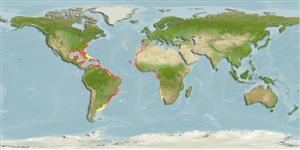Common names from other countries
Lớp phụ Cá sụn (cá mập và cá đuối) (sharks and rays) >
Carcharhiniformes (Ground sharks) >
Carcharhinidae (Requiem sharks)
Etymology: Carcharhinus: karcharos (Gr.), sharp or jagged; rhinus, an ancient name for sharks, from rhine (Gr.), rasp, both words alluding to a shark's jagged, rasp-like skin. (See ETYFish); signatus: Latin for marked, probably referring to indentation on outer margins of upper teeth (described from jaws only). (See ETYFish).
More on author: Poey.
Environment: milieu / climate zone / depth range / distribution range
Sinh thái học
Biển Sống nổi và đáy; Mức độ sâu 0 - 600 m (Ref. 244), usually 50 - 100 m (Ref. 244). Subtropical; 11°C - 16°C (Ref. 244); 39°N - 43°S, 98°W - 15°E (Ref. 55190)
Western Atlantic: Delaware to Florida (USA), Bahamas, and Cuba; southern Brazil, Argentina (Ref. 244). Eastern Atlantic: Senegal to Côte d'Ivoire, Ghana to Cameroon, Democratic Republic of the Congo, Angola, off northern Namibia (Ref. 244, 5578).
Length at first maturity / Bộ gần gũi / Khối lượng (Trọng lượng) / Age
Maturity: Lm 202.5, range 150 - 205 cm
Max length : 280 cm TL con đực/không giới tính; (Ref. 244); common length : 200 cm TL con đực/không giới tính; (Ref. 26999); Khối lượng cực đại được công bố: 76.7 kg (Ref. 40637)
Các tia vây lưng cứng (tổng cộng) : 0; Tia cứng vây hậu môn: 0. A slim shark with a very long, pointed snout, large eyes, and small jaws with oblique-cusped serrated upper teeth; dorsal fins low with elongated rear tips; interdorsal ridge present (Ref. 5578). Grey-brown above, white below; no conspicuous fin markings (Ref. 5578).
Coastal and semi-oceanic species found on or along outer continental and insular shelves (Ref. 244). Found to depths of 40 m (Ref. 26938). Forms schools (Ref. 244). Nocturnal (Ref. 5578), and feeding mainly on small bony fishes and squid (Ref. 244). Viviparous (Ref. 50449). Off West Africa, recorded water parameters at 90 to 285 m, where it was caught includes: temperature = 11 to 16°C; salinity = 36 ppt; oxygen = 1.81 ml/l (Ref. 244). Not known to be dangerous to people (Ref. 244).
Viviparous, placental (Ref. 50449), with 4 to 12 young in a litter (Ref. 244). Size at birth about 60 cm (Ref. 244). Distinct pairing with embrace (Ref. 205).
Compagno, L.J.V., 1984. FAO Species Catalogue. Vol. 4. Sharks of the world. An annotated and illustrated catalogue of shark species known to date. Part 2 - Carcharhiniformes. FAO Fish. Synop. 125(4/2):251-655. Rome: FAO. (Ref. 244)
IUCN Red List Status (Ref. 130435)
Human uses
Các nghề cá: Tính thương mại
Các công cụ
Special reports
Download XML
Các nguồn internet
Estimates based on models
Preferred temperature (Ref.
115969): 15.8 - 27, mean 21.7 (based on 178 cells).
Phylogenetic diversity index (Ref.
82804): PD
50 = 0.5000 [Uniqueness, from 0.5 = low to 2.0 = high].
Bayesian length-weight: a=0.00457 (0.00292 - 0.00715), b=3.08 (2.96 - 3.20), in cm Total Length, based on LWR estimates for this species & Genus-body shape (Ref.
93245).
Mức dinh dưỡng (Ref.
69278): 4.6 ±0.0 se; based on diet studies.
Thích nghi nhanh (Ref.
120179): Rất thấp, thời gian nhân đôi của chủng quần tối thiểu là hơn 14 năm (tm=8-10; Fec=4; Tmax=17; K=0.12).
Fishing Vulnerability (Ref.
59153): High to very high vulnerability (73 of 100).
